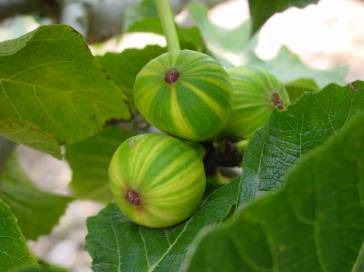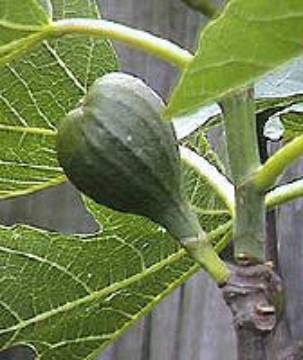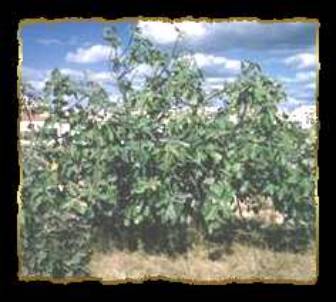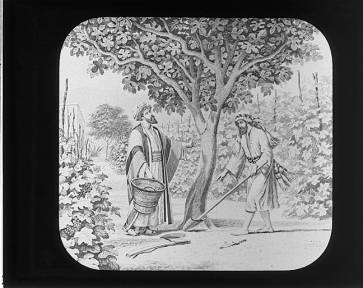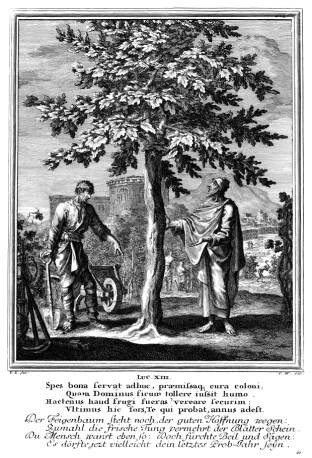
Christmas
Easter
Pentcoest
All Saints
Christ The King
Confirmation
Palm/Passion
Reformation
Stewardship
Books of the Bible
Lenten Series
Christmas Dramas
Videos
Series A - Matthew
Series B - Mark
Series C - Luke
Series D - Other
To contact
Edward F. Markquart
info@sfs.com
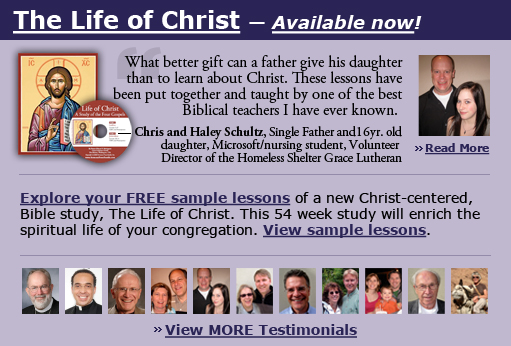
Series C Lent 2 Luke 13:1-9 The following Bible study is from a larger course entitled, THE LIFE OF CHRIST: A Study in the Four Gospels. This 54 week course for the laity will be available for congregations in 2006. Basic text for the course: SYNOPSIS OF THE FOUR GOSPELS, Kurt Aland, English Edition, P. 187 Context: Luke's "Travel Narrative": Luke 10-18 The gospel lesson for Lent 3C is part of Luke’s “travel narrative” in Luke 10-18. Within this section of Luke, there are at least six parables or events that have to do with the same theme: repentance.
#207. Repentance and Destruction (Parable of the Barren Fig Tree) Luke 13:1-9 The details of this gospel lesson are uniquely Luke. We will study the Parable of the Barren Fig tree here in Luke 13:1-9, but we could also study it later in the Jesus story when he gets to Jerusalem. In Jerusalem, we hear of Jesus cursing the fig tree during Passion Week (Mark 11:12-14 and its parallel of Matthew 21:18-19). But the story of the cursing of the fig tree during Passion Week is not part of our lectionary. Also, the story of the cursing of the fig tree as found in Matthew 21 has a distinctly different flavor from a similar story in Luke 13. In other words, if a preacher wants to preach on the fig tree which does not bear fruit, this is the Sunday to do it. There is hope in this story, hope that the fig tree can be changed and begin producing fruit. “This story is difficult to understand if one does not grasp its symbolic meaning. The tree, which had a healthy look, was in reality sterile and condemned. Perhaps it is necessary to relate these accounts in Matthew and Mark to the parable of the fig tree in Luke 13:6-9. … “The cursing of the fig tree is an enacted parable. The long patience of God has its limit.” (LAYMAN’S BIBLE COMMENTARY, MATTHEW, Suzanne de Dietrich, Volume 16)
The fig tree symbolized the Jewish religious leadership of Jesus’ day. These religious leaders talked a good religious talk and used all the right “buzz words” and clichés but did not their words into actions in their daily lives. The fig tree symbolized the Pharisees who appeared healthy (like a fig tree) but produced no fruit of love.
Today, this fig tree symbolizes any Christian life which talks the talk but does not walk the walk. The apparently healthy fig tree without fruit symbolizes an apparently healthy Christian life that does not produce actions and behaviors that God wants from us.
The tree looks healthy but it is not. A religious life looks healthy but it is not. A Christian can use all the right buzz words, read the Bible, attend church and do all the churchy things but lives a lie and does not demonstrate the love of Christ in daily actions. In today’s world, a Christian can “look religious” but is not. A person can appear to have deep faith that carries momentous burdens and appear to talk with God fervently in prayer, but at the same time, it is all a show.
In Luke’s gospel, we are reminded that Jesus often invites us to repent, turn our live around, get rid of old bad habits and produce the genuine fruits of repentance. Jesus believes in us, that we can repent and turn our lives around and get rid of old unhealthy habits, routines and patterns. We remember that “repentance” was an important word for Jesus. For example:
According to Luke 24:46-47, the theme of death and resurrection and theme of repentance and forgiveness is to be preached to all nations. Too often the Church of Jesus Christ preaches forgiveness to all nations and inadvertently leaves out the gospel message of repentence. There is an eternal oscillation between the two poles of the earth, the north pole and the south pole. Similarly in our spiriutal lives, there is an eternal oscillation in our lives between death and resurrection, Good Friday and Easter, repentance and forgiveness, selfishness and selflessness. This oscillation never ends during our lifetime. The following is an analogy about the necessity of repenting and cleaning up the sin in our lives. A few years ago in Advent, there was a Christmas tree in our sanctuary. The Christmas tree was beautiful but the lights would not come on. Why? I showed the children the electric plug. I had put tape on the plug so that the plug to the Christmas lights could not be connected with electric power. I asked the children what I should do? The children all shouted, “Take off the tape.” I did, and as soon as I scrapped off the tape and the crud, the power could flow from the light source into the lights on the Christmas tree. The tree glowed with its lights. Similarly, some of us Christians do not have the power of Christ and the light of Christ in our lives because our contact with God needs to be cleansed. That is repentance. That is what John the Baptist was all about. This is what Jesus meant when he said at the foot washing on Holy Thursday in the Book of John: “To be my disciple, you must be clean.” Repentance is washing away the sin which is deep within our lives, so that the power, love and light of God can flow into us and through us to the world. It is with these perceptions that we approach the hopefulness of Luke 13. -There were some present at that very time who told him/Jesus of the Galileans whose blood Pilate had mixed with their sacrifices. In other words, Pilate executed some Galileans (We remember that Jesus and Peter were from Galilee) and Pilate mixed the Galilean human blood with the animal blood of their sacrifices. That behavior was typical of Pilate: that is, he executed people easily and it would come as no surprise for him to have mingled human blood with animal blood. This is the first time in the gospels that we meet Pontius Pilate and we will study him more thoroughly during the trials of Jesus. We have a great deal of historical information about Pilate. We know that Pilate was the governor of Jerusalem and Judea. We know that Pontius Pilate was governor for ten years from the year 26-36 CE. We know that Pilate experienced thirty-two riots in those ten years. We know that the Jews hated the Romans, hated the Roman taxes, and hated the Roman insensitivities to their religion. Pilate wanted to take money from the temple treasury in order to build a pipeline to bring water into the city of Jerusalem. Pilate stole or borrowed the money from the temple treasury to build his aqueduct. This is what started some of the riots. When the rioting started about the water pipeline being built, Pilate ordered his soldiers to dress up as plain-clothes men and secretly to arm themselves and mingle with the rioting mobs. When the signal was given, these Roman soldiers, dressed as civilians, bludgeoned the Jews with their weapons, clubbing and stabbing the Jews to death. The neighboring governors started sending letters to Emperor Tiberius in Rome, complaining about Pilate’s brutality in handling the riots. (This useful material comes from Josephus, the historian, and Philo, the Jewish theologian, both writing at this time.)… Shortly thereafter, Pilate was removed from office because of his brutal handling of the riots. On Pilate’s trip back to Rome, Emperor Tiberius died, and we don’t ever know what happened to Pilate. Pilate disappeared into the pages of history, only to have his name repeated every Sunday in our creed, “crucified under Pontius Pilate.” Maybe our creed should have said, “Jesus was crucified under the riots of Pontius Pilate.” Yes, it is not surprising that fanaticial Pilate would mingle human blood and animal blood. -Do you think that these Galileans were worse sinners than all the other Galileans because they suffered like this? I tell you no. Jesus asked the crowd a profound question: “Do you think the sins of those Galileans caused their suffering?” Among many people, it was falsely assumed that suffering was the consequence of sinful actions. That would mean that the executed Galileans were killed because they were worse sinners than the other Galileans who were not killed. Jesus disagreed with this line of reasoning. In Jesus’ mind, there was not a simplistic, one to one correlation, between sin and suffering. -But unless you repent, you will likewise perish. Jesus used the occasion of suffering as a call to repentance and the amendment of life. There was and still is time for people to repent and change/amend their lives for the better. There was and still is time for people to get rid of those bad, unhealthy habits and attitudes and enter the kingdom of God and become a new person. Sometimes, when a great tragedy befalls our personal lives or the lives of our families or the life of our nation, it is a “wake up” call to shape up, to wise up, to grow up, and get rid of our immoral, unhealthy and selfish values, habits and stubbornly persistent patterns that make us sick and weak. -Or the eighteen upon whom the tower in Siloam fell and killed them. Do you think that they were worse offenders than all the others who lived in Jerusalem? Jesus referred to a serious tragedy that was part of the public news of the time. Siloam was a “suburb” of Jerusalem, south of the city, and news must have traveled fast and far. Jesus said to the effect: “These eighteen people did not die in a tragedy because they were greater sinners than others in town. Rather, this tragic incident is a call for each one of us to repent, to examine our own lives and make the necessary changes that go with being my disciple.” The news-making tragedy was an invitation for self-examination and change and to begin to produce the fruits of genuine repentance. Often tragedies that occur around us may speak to us in such a way that we begin to change some undesirable defects of our character. For example, a man may be under the influence of alcohol, has a car accident, kills someone and that tragedy may become a “wake up call” for him or his friends to change his/their drinking habits. The person “wakes us” to his/her drinking patterns and finally realizes that changes need to be made. Later, in the story of the Prodigal Son, we will hear about the prodigal son “coming to his senses” or “waking up” about his condition and foolish choices. Similar stories are endless. There are numerous examples of "wake up" calls that invite us to examine our lives, individually or as a nation, and come to grips that changes are needed. A man "my age" has a heart attack and dies and you realize that you personally are a workaholic and need to change the pressures that you have been putting on your life. Or, repeatedly there are traffic accidents at a particular corner without a stop light and the result has been numerous fatalities. Something needs to change or there will be more fatalaties at that corner. The theme of this particular text seems to be that there are numerous "wake up calls" in our lives where people die through no fault of their own and these "wake up calls" are invitations to make the necessary positive changes in our lives, individually or collectively. Jesus gave two examples of two current tragedies among the people of his day, and these two tragedies were invitations to change. -Unless you repent, you will likewise perish. “Perish” means to “eternally perish.” The word, “perish,” is referring to the End of Time, the Final Judgment, The Final Day that determines our final destiny. People will perish eternally. Jesus’ teachings are clear but not popular in today’s modern society when the Spirit of Jesus still teaches that people who do not repent will perish/die eternally. In the parable about the Rich Man and Lazarus, the Rich Man failed to repent and he died eternally. In that story, you get the feeling that the five brothers of the Rich Man may not have repented either and that they too would die eternally with their brother, Dives. That parable was told as motivation for the five brothers on Earth to repent, change their lives and become compassionate to the poor. -And he/Jesus told this parable. Jesus then told a parable that is familiar to many of us. It is the parable of the barren fig tree. Notice this parable is found in the parallels of Matthew 21 and Mark 11 which Jesus told during his final week in Jerusalem. In Matthew and Luke, the parable of the fig tree is a parable of judgment: “May no fruit come from you ever again. And the fig tree withered at once.” Here in the Gospel of Luke, this parable is an invitation to repent, to amend one’s life and produce the fruit of genuine repentance. That is what the Rich Man should have done. This is what the Rich Man’s five brothers needed to do. -"A man had a fig tree planted in his vineyard; Every good Jewish person of that time in history knew about fig trees. "Safety and security under the fig tree" was a symbol of the peaceful life and the good life for an average Jewish person. The Old Testament had taught, “During Solomon's lifetime Judah and Israel lived in safety, from Dan even to Beer-sheba, all of them under their vines and fig trees.” (I Kings 4:25) -and he came looking for fruit on it and found none. The owner came looking for fruit from the fig tree and found none on it. That would have been a big disappointment. The owner knew that the primary purpose of a fig tree was to produce figs. -So he said to the gardener, "See here! For three years I have come looking for fruit on this fig tree, and still I find none. The owner had been coming for three years to look at this fig tree and it still had not produced any fruit. This statement almost feels like Jesus had been working with the Pharisees for three years and they still were not producing the fruit of love. It may be that the time frame of "three years" was the time that Jesus had spent teaching his disciples about bearing fruit. Elsewhere in Luke's gospel, the Pharisees are a symbol of devoutly religous people who do not produce the fruits/love that comes from righteousness. Cut it down! Why should it be wasting the soil?' The owern says, "Cut the tree down because it is wasting the soil." It is as if a person is not a loving person of God and others, that person is wasting the time that the Lord has given. We recall the wise words from I Corinthians 13, "If I give away all that I and I deliver my body to be burned (if I am super religious) but if I am not a loving person, I am nothing." Nothing, a waste, zero.
He replied, Let it/the fig tree alone this year also until I dig about it and put on manure. And if it bears fruit next year well and good; but if it does not, you can cut it down. Luke constructs the parable of the fig tree with an element of hope. There is still time for the fig tree to bear fruit. There is still time for your life (and the lives of the Pharisees) to bear fruit. There is still time to dig around the fig tree (your life, my life) and loosen up the ground and then put manure on the ground. “If it bears fruit next year, well and good. But if it does not, you can cut it down.” In Luke’s version of the parable of the fig tree, there is still time for us to repent, change our ways, grow up, become mature human beings and bear fruit. In Luke’s version of the parable of the fig tree, there is still time for the five brothers here on earth to repent and produce the fruit of righteousness (and take care of Lazarus’s relatives) here on earth. The people are given time to change, repent, amend our ways, to begin living a life of love for others and God. In Luke's version of the parable, there is still the realism of a final judgment. That is, if the fig tree does not start producing works of love, it would be time to cut that barren tree down. The twin tragedies of the execution of the Galileans and the eighteen killed by a falling tower were two specific occasions for people to think about their eternal destiny. Today, the twin tragedies are an invitation for us to make changes in our own lives so that we are better prepared for our eternal destiny. In Luke 13, in contrast to a similar story in Matthew 21, there is hope. There is hope that I/you/we can change and bear fruit. There is hope for this fig tree to become productive. In contrast, there is an element of hopelessness for the barren fig tree in Matthew 21 that cannot and will not bear the good fruit of a loving, responsible life. http://www.4to40.com/earth/geography/htm/plantsindex.asp?counter=149 “Figs comprise a large genus, Ficus, of deciduous and evergreen tropical and subtropical trees, shrubs, and vines belonging to the mulberry family, Moraceae. Commercially, the most important fig is Ficus carica, the tree that produces the edible fig fruit. Among the most ancient cultivated fruit trees, the fig is indigenous to the eastern Mediterranean and the southwest region of Asia where its cultivation probably began. It is now grown in warm, semiarid areas throughout the world. http://www.hort.purdue.edu/ext/senior/fruits/images/large/figfruit.jpg
Figs were and still are a delight to our taste buds. The Israelites of the Old Testament remembered the savory tastes of figs, grapes and pomegranates. http://www.otan.us/webfarm/emailproject/figtree.jpg
This is what a healthy fig looks like when it is on a healthy fig tree that produces fruit.
http://focusonjerusalem.com/figtree.jpg Figs were common in Biblical time. In the Old Testament, it was said that “during Solomon's lifetime Judah and Israel lived in safety, from Dan even to Beer-sheba, all of them under their vines and fig trees.” (I Kings 4:25)
http://www.geh.org/ar/strip47/m198115630020.jpg
One man, "There is no fruit on this fig tree so it might as well be cut down unless it starts producing fruit like it should." The other man, "Let's put manure at the base of the tree and give it a year."
http://www.pitts.emory.edu/woodcuts/1712BiblA/00002515.jpg
The barren fig tree looked good but there was no fruit on it.
http://catholic-rcia.com/images/Parable_pictures/Fig%20Tree.jpg “Like a tree, it is best for me to be pruned of a lot of dead branches so I Lent 3 |
